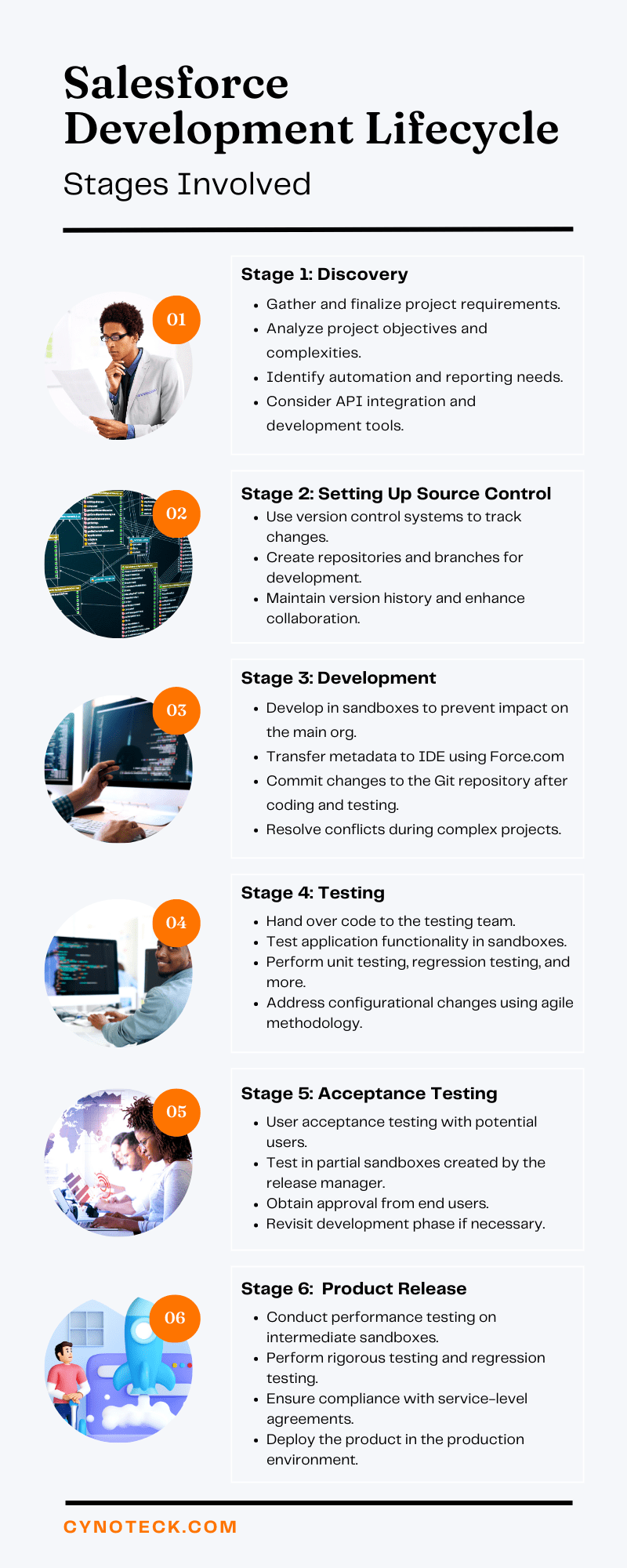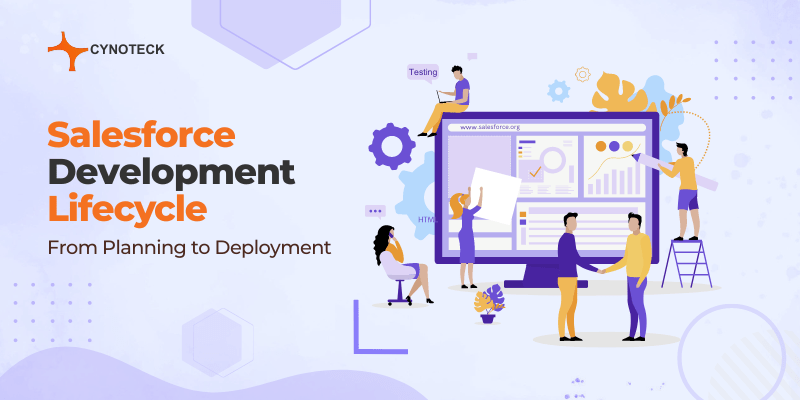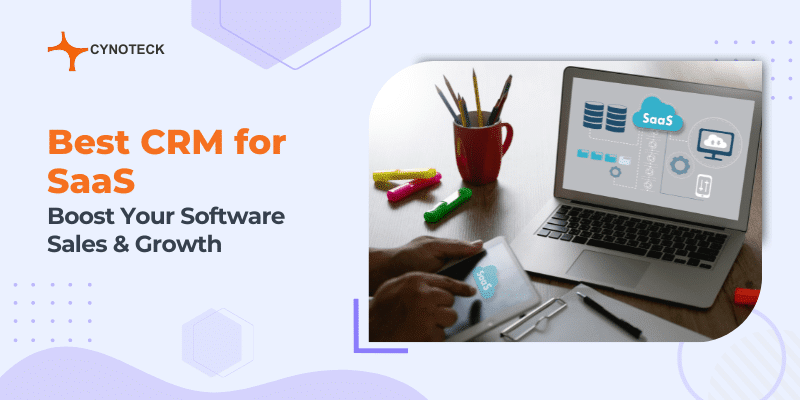To stand firm and survive in this evolving digital landscape, organizations must prioritize effective and value-driven app development. By creating secure and robust applications, businesses can significantly improve productivity and deliver a customer-centric experience. In today’s world, cloud-based Salesforce CRM has emerged as the preferred option for organizations and enterprises. This comprehensive Salesforce development lifecycle guide provides invaluable insights into Salesforce application development, empowering businesses to stay ahead in the market and succeed.
Salesforce offers powerful solutions to address different business challenges across businesses, from SMBs to Enterprises. Its flexibility allows for extensive configuration, allowing organizations to tailor it to their specific requirements. While application development in Salesforce is comparatively straightforward, organizations need to adopt a business-centric strategy guided by experienced development teams to ensure seamless success.
To provide comprehensive insights into application development, we have covered everything about Salesforce Development Lifecycle, including processes, models, and challenges, below. This will provide you with valuable knowledge to drive the Salesforce development journey effectively.
Salesforce Development – Overview
Salesforce Development includes the creation and enhancement of features, services, and applications within the Salesforce platform. Salesforce allows the development of diverse applications and services using its multitenant architecture and seamless integration capabilities.
Key programming languages such as Visualforce and Apex play a crucial role in Salesforce development, allowing developers to build robust solutions tailored to specific business requirements.
With its exceptional attributes, Salesforce development has become the preferred option for businesses worldwide. By incorporating key programming and automation techniques, Salesforce development offers unparalleled capabilities across diverse industry segments, enabling seamless operations.
Experienced and intuitive Salesforce developers possess the expertise to formulate outstanding elements that drive business growth. Leveraging Salesforce’s potential, businesses can achieve excellent outcomes and drive their development efforts to new heights.
Also, read: 15 Best Salesforce Integrations for Optimizing Your Business Operations
Salesforce Development Lifecycle
The Salesforce Development Lifecycle plays an important role in the overall Software Delivery Lifecycle (SDLC). A notable feature of the Salesforce development lifecycle is its utilization of a centralized file system.
It’s important to highlight that Salesforce developers are required to migrate any modifications to the source control repository before they are applied to the Salesforce platform.
This detailed process ensures data integrity and promotes effective collaboration within the development environment.
By adhering to this structured approach, organizations can optimize their Salesforce development efforts and drive successful software delivery.
Supercharge Your Salesforce with Expert Development Services!
Unlock Salesforce’s potential with our top-notch development services. Maximize efficiency, enhance user experience, and drive growth.
Salesforce Development Lifecycle – Stages Involved
The Salesforce development lifecycle involves six different phases, each meticulously planned to accomplish specific objectives, ensuring a successful outcome for your Salesforce project.
These phases guide the progression of the project from initiation to completion, allowing for effective planning, development, testing, and deployment.
By following this structured approach, organizations can optimize their Salesforce development efforts, mitigate risks, and deliver high-quality solutions that align with their business goals.

1) Discovery
The Discovery Phase is the initial stage of the Salesforce development lifecycle, where complete requirements are gathered, reviewed, and finalized for development.
This crucial phase involves a thorough analysis of project objectives, key requirements, development complexities, automation needs, reporting requirements, previous implementation gaps, API integration considerations, development tools, and preferred development approaches.
The insights gained during this phase set the basis for the subsequent stages of the development process, ensuring a well-informed and efficient development approach.
2) Setting Up Source Control
Source control or version control systems play a vital role in tracking changes made to files during software development. In the Salesforce development lifecycle, a release manager initiates a project by creating repositories and branches within the version control system.
By utilizing source control effectively, development teams can maintain version history, manage code changes, and enhance collaboration and productivity throughout the Salesforce development process.
Let’s look at the components of version control to better understand it:
i) Repository
Repositories serve as centralized containers for version control, enabling real-time tracking of file changes. They consist of a central master store of files, with multiple branches dedicated to developing new features.
By utilizing separate repositories, you can effectively monitor changes, review fellow developers’ work, and resolve conflicts. This ensures seamless integration of new features into the Salesforce environment.
ii) Branches
Branches serve as independent working environments for developers to build and test new features separately from ongoing development work. They facilitate parallel development and grant developers control over changes during product testing and release.
It is recommended to maintain separate Git repositories for different projects, allowing for seamless merging of data with the main application.
The release manager plays a vital role in task assignments based on each developer’s expertise, ensuring efficient development and integration processes.
Also, read: Boosting Sales Performance: How Salesforce Benefits Your Sales Team
3) Development
During this process, developers work on the production environment in sandboxes to prevent any impact on the main Salesforce org. They utilize Force.com to establish a connection with their sandbox and transfer metadata to the IDE (Integrated Development Environment).
After coding and performing unit testing, the changes are transferred to the Git repository. In complex projects involving multiple developers working on the same code, the development team must check for conflicts before committing the code to the repository.
4) Testing
After the development phase, the code is handed over to the testing team. The QA team maintains sandboxes to test the code, much like engineers do. Partial copy sandboxes are commonly preferred by Salesforce testers as they allow testing of application functionality without the need to load complete data.
Various testing types are performed by Quality Analysts in a Salesforce application development project, including unit testing, regression testing, performance testing, integration/API testing, visual testing, and load testing. Agile methodology is often followed, allowing easy addressing of configurational changes during this phase.
5) Acceptance Testing
After the QA testing, the Salesforce development project proceeds to user acceptance testing, involving potential users to ensure the solution meets expectations.
Product managers use partial sandboxes created by the release manager for testing. Once end users provide their approval, the solution is ready for release.
However, any suggested changes at this phase may require revisiting the initial development phase.
6) Product Release
In the final phase, thorough performance testing is conducted on intermediate sandboxes, including all solution features. Rigorous testing, including regression testing, is performed to ensure the product meets all service-level agreements. Once all testing levels are completed, the product is ready for release and deployment in the production environment.
Also, read: Salesforce CPQ vs Standard Quotes: Which is Right for Your Business?
Salesforce Development Models
Unlike custom application development where the code repository serves as the single source of truth, Salesforce development offers various development models to choose from. The choice of model depends on factors such as the complexity of the change, team size and skills, and the metadata being worked on.
Each development model has its advantages, disadvantages, and limitations. When choosing an option for deployment, consider your objectives, team capabilities, and Salesforce constraints. It’s possible to use different approaches for different projects or even combine approaches within a single project.
Here is a list of the various Salesforce development models:
1) Org Development Model
The org development model is suitable for working with orgs that don’t have source trackings, such as sandboxes, Developer Edition (DE) orgs, Trailhead Playgrounds, or even production orgs.
In this model, changes need to be manually tracked, and sandboxes’ changes must be manually deployed to the production org. Releases and updates are developed and scoped directly to the production org, ensuring familiarity with the technologies and lifecycle.
However, coordination can be challenging without continuous integration, and it lacks an agile methodology, making rollback and automated testing difficult.
Using the Org development model for development:
- The steps for using the org model in development are listed below.
- Using a manifest to create a project;
- Using the Org Picker to authorize the org that you are going to be developing against;
- Obtaining the source from the default org using the org browser or manifest;
- Deploying the source to the default Org.
2) Package Development Model
For complicated and large Salesforce development projects, a team of at least five developers is typically involved, each responsible for different features of the application. Tracking changes across the active team can be challenging.
The package development model is well-suited for such projects, allowing the creation of self-contained applications or libraries deployed as a single package.
This model depends on source-tracked orgs like scratch orgs and employs org source tracking, source control, and continuous integration and deployment.
It ensures efficient tracking of changes and allows effective collaboration within the development team.
Why consider the Package development model?
The package development model is an excellent option because of:
- You can use the model to construct properly defined packages and organize the production org’s unpackaged metadata;
- It enables you to split up big sets of functionalities into more manageable pieces, making it simpler to keep track of changes;
- It supports Salesforce’s modular development concept;
- The directories can be used to generate packages that are simple to maintain, upgrade, install, and update;
- You can manage the source with Salesforce DX projects by organizing it into package directories.
Listed below are the steps for creating a project using a package development approach:
- Creating a project;
- Source of Pushing and Pulling;
- View changes.
Also, read: Salesforce Service Cloud Use Cases with Examples
Say Goodbye to Manual Data Entry and hello to Streamlined Workflows that Spark Joy.
Join us on a journey of automation, accuracy, and time-saving exhilaration. Try CTK Email Parser today and elevate your business to new heights!
How Salesforce Development Can Help a Business Grow and Succeed?
For sales and marketing teams, Salesforce acts as a centralized automation hub, enabling them to efficiently customize products and solutions for customers. It offers a consistent framework for seamless planning and management at the team and organizational levels.
Salesforce enables teams to focus on important goals like improving customer relationships and refining corporate workflows through streamlining processes.
The benefits of Salesforce Development for Your Business are as follows.
1) You can design user-friendly software
To create software solutions that promote business success, you can e use Salesforce capabilities and cloud-based business models. This can help in process automation, the creation of new products, improving teamwork, data analytics, and more.
Salesforce’s integration capabilities and cloud-based architecture can help you in developing custom solutions to grow your business.
2) Make Precise and Better Decisions
Businesses can obtain important insights into their industry and daily operations by utilizing Salesforce development. They can accurately assess their current state and plan for the future with the help of real-time data.
Organizations can furthermore enhance performance, make educated decisions, and ultimately succeed by utilizing predictive analytics.
3) Save time, money, and effort
Salesforce development unlocks a plethora of possibilities for organizations, minimizing the need for extensive coding by offering customized solutions.
The platform equips businesses with essential tools like templates, point-and-click functionality, embedded analytics, and personalized reports, fostering flexibility, cost-effectiveness, and prosperity.
By harnessing these capabilities, organizations can seamlessly bring their visions to life, turning aspirations into real achievements.
4) Empower the sales and marketing teams
Salesforce development services play a crucial role for businesses seeking to improve their growth by tailoring Salesforce CRM to their requirements.
These services enable the creation of personalized dashboards and reports, empowering businesses to effectively track leads, implement customized marketing campaigns, and monitor customer interactions.
As a result, businesses can experience improved sales performance and revenue growth.
5) Analyse your competitors
By leveraging Salesforce CRM analytics, businesses can gain valuable insights into their competitors’ sales, marketing, and customer interaction strategies.
This enables them to gain a competitive advantage by benchmarking their performance against their rivals, identifying areas for enhancement, and informing product development and pricing strategies.
This results in making informed decisions while staying ahead in the market.
Also, read: Salesforce Use Cases: How Companies Boost Sales with CRM
Salesforce Development Lifecycle – Challenges Faced
Despite having a clear vision and plan for your Salesforce Development process, there are potential hurdles that can hamper your capability to fully leverage its benefits. Here are some unique challenges that you might face in the Salesforce development process:
1) Customization Complexity
Customizing Salesforce to align with specific business requirements can bring challenges in managing complex customizations. Striking a balance between customization, scalability, and maintainability can be challenging.
Salesforce offers a range of customization options, but it is essential to invest time in understanding which tools best address current needs. Achieving a tailored Salesforce solution requires a deep understanding of business requirements and technical expertise.
With careful consideration and expertise, businesses can successfully leverage Salesforce’s customization capabilities to meet their unique needs.
2) Uncertainty About User Permission
Effective user management in Salesforce demands expertise in customizing user permissions, creating profiles, and establishing a proper hierarchy.
However, organizations often underestimate the importance and complexity of this aspect, leading to potential risks to data integrity. Inadequate knowledge can result in granting excessive administrative permissions to users who do not require them.
Therefore, it is crucial to approach user management with care and ensure that permissions are appropriately assigned to maintain data security and integrity.
3) Lack of Knowledge and Expertise
As Salesforce continues to evolve with new features and updates, it becomes essential to have experienced developers with expertise in different Salesforce domains.
While having such skilled individuals on your team is not always necessary, investing in Salesforce and expecting a return on that investment requires considering options like hiring a Salesforce Developer or engaging the services of a certified Salesforce Development partner.
This ensures that you have access to professionals who can maximize the benefits of Salesforce for your business.
4) Lack of Support From Salesforce
While Salesforce offers a free support plan, their response time can be up to 2 days, and they primarily provide guidance rather than directly resolving issues.
Users can handle common Salesforce issues, but complex technical challenges require expertise from Salesforce experts or experienced partners who have successfully resolved a wide range of CRM problems.
Additionally, Salesforce integration partners specialize in customizing the platform to meet specific business needs, elevating the CRM to a higher level of functionality.
Partnering with these experts can ensure effective problem-solving and unlock the full potential of Salesforce for your organization.
Also, read: Salesforce Report Types for Best Data Visualization
Also, watch our video on: Salesforce Development Life Cycle – From Planning to Deployment: https://youtu.be/LwZ-YQ3zs98?si=a4Y-MHCEnCEAh0Hs
Conclusion
Salesforce development enables seamless collaboration among developers, leveraging a diverse range of tools to enhance application efficiency. The success of Salesforce development projects relies on meticulous planning and dedicated effort across different phases.
To ensure a smooth Salesforce development lifecycle, organizations need to establish clear goals and a well-defined path to achieve them. Engaging stakeholders in discussions regarding project objectives and addressing any gaps can foster consensus before engaging with developers. This proactive approach sets the foundation for a successful Salesforce development journey.
With over a decade of experience in Salesforce development, we have amassed a robust portfolio of successful clients. Our expertise in the software, combined with our deep understanding of your specific requirements, sets us apart. Contact us today to discover the full range of our Salesforce development services and embark on your journey to success.
Also, read: An overview of what is Account Teams in Salesforce
FAQs (Frequently Asked Questions)
The Salesforce development lifecycle includes best practices and processes for building custom applications on the Salesforce platform. By adhering to this lifecycle, organizations can effectively manage, test, and deploy their development work with minimal risk and disruption. Following this structured approach ensures consistency, and reliability, and reduces the chances of issues in the production environment.
Salesforce offers sandboxes and deployment tools to facilitate the isolation of customization and development work from the production environment. This ensures that changes can be thoroughly tested against replicated production data and users, while also providing a dedicated training environment. Furthermore, the deployment tools streamline the process of combining individual changes into a single deployment to the production environment.
Efficient monitoring is essential for a seamless and successful deployment. It facilitates prompt detection and resolution of any potential issues. To achieve this, it is vital to establish dependable and automated metrics while implementing a monitoring process that offers real-time insights. By integrating these monitoring practices, organizations can effectively manage their deployment and proactively tackle any challenges that may emerge.
The Salesforce Development Lifecycle begins with the essential task of outlining requirements and establishing business objectives. These are subsequently transformed into user stories and functional requirements, serving as the guiding principles for the development process. The subsequent step revolves around crafting a comprehensive solution, encompassing the creation of data models, user interfaces, and procedural workflows.
Once the design phase reaches fruition, the solution is implemented through meticulous coding, rigorous testing, and seamless system integration. This meticulous and systematic approach ensures the professional execution of Salesforce development, aligning with industry best practices and delivering optimal outcomes.

Salesforce Consulting Services
If you are new to automation and confused about Workflow or Process Builder. Need not to worry, we have got you all covered. Talk to our experts and clear all the cloudy thoughts about automation.




